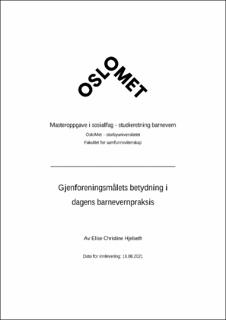| dc.contributor.advisor | Aamodt, Hilde Anette | |
| dc.contributor.author | Hjelseth, Elise Christine | |
| dc.date.accessioned | 2021-11-03T11:51:20Z | |
| dc.date.available | 2021-11-03T11:51:20Z | |
| dc.date.issued | 2021 | |
| dc.identifier.uri | https://hdl.handle.net/11250/2827575 | |
| dc.description.abstract | Studiet er rettet mot feltet barnevern og kontaktpersoner arbeid med gjenforeningsmålsettingen. Formålet med studiet er å synliggjøre forståelsen og anvendelsen av gjenforeningsmålet i det kommunale barnevernet. Å belyse kontaktpersoners forståelse av gjenforeningsmålet og hvordan man jobber mot dette målet i praksis vil kunne gi anledning til kunnskapsutvikling og videre diskusjon. Problemstillingen for oppgaven har vært: Hvordan viser gjenforeningsmålet seg i dagens barnevernpraksis? Og har fire tilhørende forskningsspørsmål: forståelsen av begrepet gjenforeningsmålet, holdninger til gjenforeningsmålet, hvordan tid og ressurser påvirker gjenforeningsarbeidet og hvordan gjenforeningsarbeidet utføres i praksis.
Dette studiet er en kvalitativ semistrukturert intervjustudie. Utvalget består av 6 kontaktpersoner som er ansatt i ulike kommunale barneverntjenester i Norge. Analyseprosessen ble gjennomført ved bruk av en eklektisk analytisk tilnærming (Kvale & Birkheim, 2019, 2. 263) Tilnærmingene som ble benyttet i analyseprosessen er det Thagaard (2018, s. 151) betegner som kontekstanalyse og temasentrert analyse. I lys av datamaterialet som ble utarbeidet etter intervjuene, kom teorigrunnlaget frem. For å kunne forstå vurderinger og beslutninger som kontaktpersoner må ta i gjenforeningarbeidet, er det viktig med en grunnleggende forståelse om barnevernets hovedoppgaver og juridiske rammer. Videre ble det presentert en teoridel om barnevernets handlingsrom, der kontaktpersoners skjønnsutøvelse og teorien om bakkebyråkrati ble presentert. Funnene i studiet viser en stor variasjon av forståelsen av selve begrepet gjenforeningsmålet. Videre viser funnene at flere av kontaktpersonene har ambivalente holdninger rundt gjenforeningsmålet. Noen var positive til bevisstgjøringen av viktigheten av det biologiske prinsipp, mens flertallet understreket utfordringene et økende fokus på gjenforeningsmålet ville skape. Hvilke forutsetninger kontaktpersoner har for å kunne jobbe tilstrekkelig med gjenforeningsarbeidet, viste seg å være preget av tid- og ressursmangel. Tid og ressursmangel fører til prioriteringer, og funnene viste at gjenforeningsarbeidet ble en andre prioritet når man ikke kunne rekke over alt. Funnene viste videre at gjenforeningsarbeidet var basert på ulike praksiser. Noen av kontaktpersonen forklarte at de ikke hadde noen form for nedskrevne rutiner, mens andre kunne vise til interne praksiser innad i barneverntjenesten. | en_US |
| dc.description.abstract | This study is aimed at the field of child welfare service and contact persons work with the reunification objective. The purpose of this study is to make visible the understanding and application of the reunification goal in the municipal child welfare service. Elucidating contact persons' understanding of the reunification goal and how to work towards this goal in practice could provide an opportunity for knowledge development and further discussion. The problem for the thesis has been: How does the reunification goal manifest itself in today's child welfare practice? with four associated research questions: understanding the concept of reunification goals, attitudes to reunification goals, how time and resources affect reunification work and how reunification work is carried out in practice. This study is a qualitative semi-structured interview study. The committee consists of 6 contact persons who are employed in various municipal child welfare services in Norway. In this study, the analysis process was carried out using an eclectic analytical approach (Kvale & Birkheim, 2019, 2. 263) The approaches used in studies are what Thagaard (2018, p. 151) describes as context analysis and theme-centered analysis.
In order to be able to understand assessments and decisions that contact persons must make in the reunification work, it is important to have a basic understanding of the child welfare service's main tasks and legal framework. Furthermore, a theoretical part was presented on the child welfare service's room for maneuver, where contact persons' exercise of discretion and the theory of ground bureaucracy were presented. The findings of the study show a great variety of understanding of the very concept of reunification goals. Furthermore, the findings show that several of the contact persons have ambiguous attitudes around the reunification goal. Some were positive about raising awareness of the importance of the biological principle, while the majority mentioned important challenges that would come up when increasing the focus on the goal of reunification. The various prerequisites for contact persons to be able to work adequately with the reunification work turned out to be characterized by a lack of time and resources. Time and lack of resources lead to priorities, and the findings showed that reunification work became another priority when one could not reach everywhere. The findings further showed that the reunification work was based on different practices. Some of the contact persons explained that they did not have any kind of written down routines, while others could refer to internal practices within the child welfare service. | en_US |
| dc.language.iso | nob | en_US |
| dc.publisher | OsloMet-Storbyuniversitetet | en_US |
| dc.subject | Barnevern | en_US |
| dc.subject | Gjenforeningsmålet | en_US |
| dc.subject | EMD | en_US |
| dc.title | Gjenforeningsmålets betydning i dagens barnevernpraksis | en_US |
| dc.type | Master thesis | en_US |
| dc.description.version | publishedVersion | en_US |
